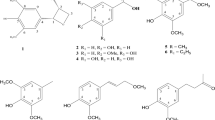Abstract
Six new pyrrole 2-carbaldehyde derived alkaloids, dahurines A–F (1–6), along with five known ones (7–11) and butyl 2-pyrrolidone-5-carboxylate (12) were isolated from the roots of Angelica dahurica. Their structures were determined by extensive spectroscopic and spectrometric data (1D and 2D NMR, IR, and HRESIMS) and calculated electronic circular dichroism (ECD) methods. Although compounds 7 and 8 have been chemically synthesized, they were obtained from natural materials for the first time. Compounds 2, 3, 4, 10, and 11 exhibited acetylcholinesterase inhibitory activity with IC50 values in the range of 47.5–52.5 μM.
Graphic abstract
Pyrrole 2-carbaldehyde derived alkaloids from the roots of Angelica dahurica






Similar content being viewed by others
References
Chinese Pharmacopoeia Commission (2015) Pharmacopoeia of the People’s Republic of China, vol I. Chemical Industry Press, Beijing, pp 105–106
Kwon YS, Shin SJ, Kim MJ, Kim CM (2002) A new coumarin from the stem of Angelica dahurica. Arch Pharm Res 25:53–56
Kwon YS, Kobayashi A, Kajiyama SI, Kawazu K, Kanzaki H, Kim CM (1997) Antimicrobial constituents of Angelica dahurica roots. Phytochemistry 44:887–889
Thuong PT, Hung TM, Ngoc TM, Ha DT, Min BS, Kwack SJ, Kang TS, Choi JS, Bae KH (2010) Antioxidant activities of coumarins from Korean medicinal plants and their structure–activity relationships. Phytother Res 24:101–106
Thanh PN, Jin WY, Song GY, Bae K, Kang SS (2004) Cytotoxic coumarins from the root of Angelica dahurica. Arch Pharm Res 27:1211–1215
Baek NI, Ahn EM, Kim HY, Park YD (2000) Furanocoumarins from the root of Angelica dahurica. Arch Pharm Res 23:467–470
Liu DP, Luo Q, Wang GH, Xu Y, Zhang XK, Chen QC, Chen HF (2011) Furocoumarin derivatives from radix Angelicae dahuricae and their effects on RXRα transcriptional regulation. Molecules 16:6339–6448
Seo WD, Kim JY, Ryu HW, Kim JH, Han SI, Ra JE, Seo KH, Jang KC, Lee JH (2013) Identification and characterisation of coumarins from the roots of Angelica dahurica and their inhibitory effects against cholinesterase. J Funct Foods 5:1421–1431
Yang WQ, Song YL, Zhu ZX, Su C, Zhang X, Wang J, Shi SP, Tu PF (2015) Anti-inflammatory dimericfuranocoumarins from the roots of Angelica dahurica. Fitoterapia 105:187–193
Yang WQ, Zhu ZX, Song YL, Qi BW, Wang J, Su C, Tu PF, Shi SP (2017) Dimeric furanocoumarins from the roots of Angelica dahurica. Nat Prod Res 31:870–877
Lu J, Jin L, Jin YS, Chen HS (2007) Chemical constituents in roots of Angelica dahurica var. formosana. Acad J Second Mil Med Univ 28:294–298
Wood JM, Furkert DP, Brimble MA (2018) 2-Formylpyrrole natural products: origin, structural diversity, bioactivity and synthesis. Nat Prod Rep. https://doi.org/10.1039/c8np00051d
Kim SB, Chang BY, Jo YH, Lee SH, Han SB, Hwang BY, Kim SY, Lee MK (2013) Macrophage activating activity of pyrrole alkaloids from Morus alba fruits. J Ethnopharmacol 145:393–396
Youn UJ, Lee JY, Kil YS, Han AR, Chae CH, Ryu SY, Seo EK (2016) Identification of new pyrrole alkaloids from the fruits of Lycium chinense. Arch Pharm Res 39:321–327
Dong Y, Pai NN, Ablaza SL, Yu SX, Bolvig S, Forsyth DA, Quesne PWL (1999) Quararibea metabolites. 4. Total synthesis and conformational studies of (±)-funebrine and (±)-funebral. J Org Chem 64:2657–2666
Yao CP, Zou ZX, Zhang Y, Li J, Cheng F, Xu PS, Zhou G, Li XM, Xu KP, Tan GS (2018) New adenine analogues and a pyrrole alkaloid from Selaginella delicatula. Nat Prod Res. https://doi.org/10.1080/14786419.2018.1482892
Fang CW, Chen JJ, Liu SJ (2010) Studies on the chemical constituents of rhizoma of Coniogramme japonica. J Chin Med Mater 33:557–559
Matsumoto T, Nakamura S, Ohta T, Fujimoto K, Yoshikawa M, Ogawa K, Matsuda H (2015) A rare glutamine derivative from the flower buds of daylily. Org Lett 16:3076–3078
Park MR, Kim YC, Lee S, Kim IS (2009) Identification of an ISR-related metabolite produced by rhizobacterium Klebsiella oxytoca C1036 active against soft-rot disease pathogen in tobacco. Pest Manag Sci 65:1114–1117
Wang MZ, Sun MW, Hao HL, Lu CH (2015) Avertoxins A–D, prenyl asteltoxin derivatives from Aspergillus versicolor Y10, an endophytic fungus of Huperzia serrata. J Nat Prod 78:3067–3070
Ying YM, Shan WG, Zhan ZJ (2015) Biotransformation of Huperzine A by a fungal endophyte of Huperzia serrata furnished sesquiterpenoid–alkaloid hybrids. J Nat Prod 77:2054–2059
Qi BW, Liu X, Mo T, Zhu ZX, Li J, Wang J, Shi XP, Zeng KW, Wang XH, Tu PF, Abe I, Shi SP (2017) 3,5-Dimethylorsellinic acid derived meroterpenoids from Penicillium chrysogenum MT-12, an endophytic fungus isolated from Huperzia serrata. J Nat Prod 80:2699–2707
Qi BW, Liu X, Mo T, Li SS, Wang J, Shi SP, Xiao XH, Zhu ZX, Zhao YF, Jin HW, Tu PF, Shi SP (2017) Nitric oxide inhibitory polyketides from Penicillium chrysogenum MT-12, an endophytic fungus isolated from Huperzia serrata. Fitoterapia 123:35–43
Acknowledgements
This work was partially supported by the National Natural Science Foundation of China (no. 81573312).
Author information
Authors and Affiliations
Corresponding author
Ethics declarations
Conflict of interest
The authors declare no conflict of interest.
Additional information
Publisher's Note
Springer Nature remains neutral with regard to jurisdictional claims in published maps and institutional affiliations.
Electronic supplementary material
Below is the link to the electronic supplementary material.
Rights and permissions
About this article
Cite this article
Qi, B., Yang, W., Ding, N. et al. Pyrrole 2-carbaldehyde derived alkaloids from the roots of Angelica dahurica. J Nat Med 73, 769–776 (2019). https://doi.org/10.1007/s11418-019-01328-1
Received:
Accepted:
Published:
Issue Date:
DOI: https://doi.org/10.1007/s11418-019-01328-1




